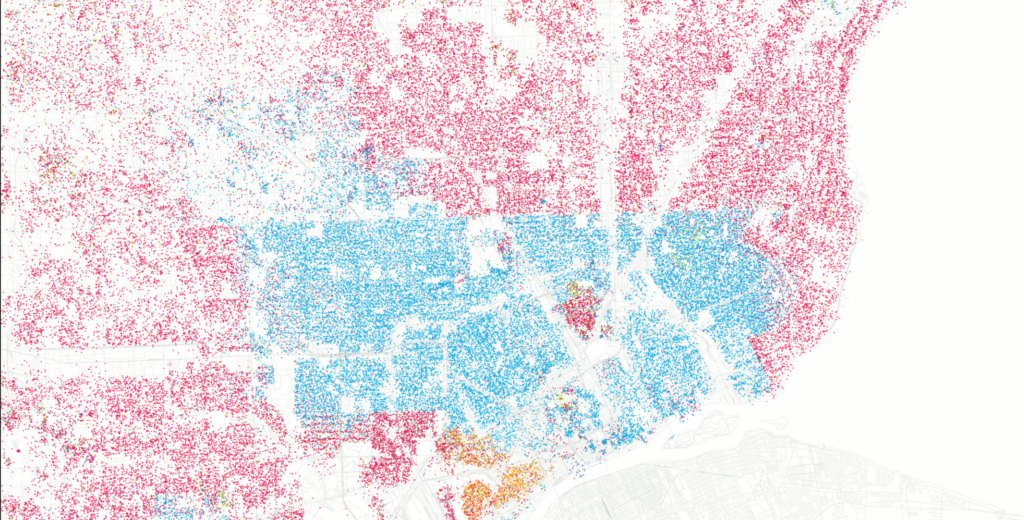The Smart Enough City: Putting Technology in Its Place to Reclaim Our Urban Future
Ben Green
MIT Press; $24.95 (cloth)
The Urban Commons: How Data and Technology Can Rebuild Our Communities
Daniel T. O'Brien
Harvard University Press; $35.00 (cloth)
In 1854, a physician named John Snow walked around the London neighborhood of Soho during an ongoing cholera outbreak. At the time, cholera was thought to spread through “bad air” or pollution, but Snow interviewed residents and, on a map, marked exactly who and where cholera was affecting. His data eventually revealed a cluster concentrated around a specific water pump on Broad Street. Victims of cholera in other parts of the neighborhood, he discovered, either went to school or work near the Broad Street pump. The city quickly disabled the well pump at his urging, and the cholera outbreak soon came to an end.
Ours is a critical moment when we can either give-in to the currents of big data, or we can realize that it too will trap us in familiar patterns and histories.
One hundred and sixty years later, across the pond in New York, a small outbreak of Legionnaires’ disease was threatening citizens. The bacteria lurked in a specific kind of air conditioner, which the city never before had reason to track. In a similar battle against the clock, the city turned to machine learning to help narrow down the buildings that might house the air conditioners and need to be inspected. The taskforce completed the task—identifying, inspecting, and cleaning every cooling tower in New York City that needed it—and staved off a full-blown attack in just weeks.
Cities have always relied on the collection of data to inform their decisions. The differences in response to these two lethal outbreaks are scale and type. In 2015, New York City trained its machine learning on tax records, inspection reports, and building plans. These records existed in rough form in 1854, but now they can be collected, stored, and analyzed in immensely larger amounts. Cities today also have types of data that Snow couldn’t have imagined: biometrics, passive device sniffing, and credit histories. Indeed, the next frontier of city planning and public infrastructure is data, and as with past generations of infrastructure, elected officials and their private sector allies are eager to show their alignment with the future. There is a competition unfolding, and the winners get to be “Smart Cities,” which sounds a lot better than the alternative.
To be fair, this race to display technical savvy has affected almost every professional field in some way. Indeed, we’ve had more than a decade of essays welcoming the evolution. Wired magazine’s 2008 essay, “The End of Theory: The Data Deluge Makes the Scientific Method Obsolete,” is remembered to this day as best capturing the breathless impatience for a surrender to data.
“Out with every theory of human behavior, from linguistics to sociology,” Chris Anderson wrote at the time. “Forget taxonomy, ontology, and psychology. Who knows why people do what they do? The point is they do it, and we can track and measure it with unprecedented fidelity. With enough data, the numbers speak for themselves.”
The Wired essay was talking about biology, but it alluded directly enough to the social sciences that now, over a decade later, it has inspired specific challenges from two recent urban planning books. In retrospect, there is much to protest. The Wired essay, after all, harbored echoes of the paternalistic and cavalier approaches that past generations of city planners applied as they racked the public good. In the early days of federal housing policies, for example, lending institutions claimed unassailable reasoning while refusing to grant mortgages to non-whites outside “redlined” zones. Later, transportation engineers wrapped themselves in pseudo-scientific metaphors about cardiovascular health as they tore apart those non-white communities to “unclog urban arteries” with freeways.
“At the very moment,” Ben Green writes in the new book The Smart Enough City, “that cities are undoing the damage created by last century’s misguided dreams, we appear ready to revert back to our old habits.” Ours, these new books show, is the critical moment when we can either give-in to the currents of big data, or we can realize that it too will trap us in familiar patterns and histories. As Green warns, the search for “objective, technical solutions to social issues is dangerous,” but by centering race and equity in our data infrastructure discourse we can achieve not only atonement, but also our only strategy for being resilient against the challenges of the future.
•••
In The Smart Enough City, Green—a PhD Candidate in Applied Math at the Harvard School of Engineering and Applied Sciences—wants readers to ignore the pressure to be a “smart” city and instead figure out what is required to be smart enough. Green’s stated objective is to explore “why, far too often, applications of technology in cities produce adverse consequences.” His central thesis is that by allowing ourselves to get swept up in the data hype, we reframe complex social and political issues as technical puzzles. Solving these puzzles draws our focus from the real challenges. Rather than splitting the world into “smart” cities and the implied alternative of dumb ones, Green urges cities to focus on process improvements first and only incorporate as much data and technology as those improvements require.
Failing fast and often, a popular mantra in technology, isn’t an option when your users can’t opt out.
Take the Legionnaires’ outbreak in New York City. In Green’s telling, the real innovation in effectively containing the outbreak was not the use of machine learning, but in the inclusive process to create its training dataset: the city brought together existing teams, interviewed experienced stakeholders, and continues to hold recurring “data drills” to practice for future crises. Machine learning allowed them to tackle more data at once, yes, but it was actually an offhand comment from a firefighter that narrowed the search and prevented a more massive loss of life.
Exercising this kind of focus on process and restraint of technology isn’t easy, and The Smart Enough City is remarkably positive for what is essentially a collection of examples that end with people in bureaucracies asking, “What if we moved more slowly?” But as each case reminds us, there are risks for moving too quickly in the public sector. Failing fast and often, a popular mantra in technology, isn’t an option when your users can’t opt out. The potential for deep and lasting harm is severe enough to justify asking harder questions. The storytelling structure and cadence in The Smart Enough City may strike readers as a natural companion to Weapons of Math Destruction (2016) by Cathy O’Neil, though with a specialized focus and more optimistic message.
The Urban Commons (2018), by Daniel O’Brien, Associate Professor in the School of Public Policy and Urban Affairs at Northeastern University and Co-Director of the Boston Area Research Initiative, also pushes back against the tech narrative that civic data can provide a useful function without theory. Fantastical statements such as those found in the Wired article about what happens with “enough data” are counterproductive when civic institutions are constrained by cost and constituents, he argues. O’Brien specifically explores motivations around constituent engagement—such as 311 programs—arguing that cities must understand why people choose to co-produce civic data if we are to design infrastructure that can use it effectively.
311 reporting allows individuals to report non-emergency issues such as graffiti or potholes, attach photos and locations, and track their report as it winds through its municipal maze towards completion. Over 200 cities in the United States are integrated with similar services, provided by either a municipality or one of several for-profit entities.
The Urban Commons is an example of the mirage of objectivity. The analysis focuses heavily on quantification without interrogating subtext.
A popular hypothesis about 311 systems is that people only submit reports to enhance their own property values, but O’Brien focuses on Boston’s system and applies a rigorous social science challenge. He introduces and tests an alternative thesis: “that custodianship, and therefore the maintenance of the urban commons, is rooted in the innate human capacity for territoriality.” When surveyed, participants were much more likely to positively rank “benefiting the community” or “enforce local norms” as their motivations, whereas they ranked the motivation to “maintain property values” as below neutral.
Beyond the question of why people participate in data custodianship, O’Brien also explores how they participate. Again, he starts with a popular hypothesis: that public places suffer from the free rider problem, and densely populated neighborhoods will be underreported. He finds instead evidence for a “division of labor” model, which sees “exemplars” (frequent reporters) distributed throughout the city, and that dense areas present “more opportunities for someone to take action, even if each individual is less likely to do so.”
Building upon these and other conclusions, O’Brien tests whether or not participation in 311 is related to civic duty (the “public-as-citizen” model) or territoriality (“public-as-partner”). Again, territoriality seems to be the primary motivation. Other civic behavior, such as voting, did not correlate strongly with 311 reporting overall. Interestingly, voting did correlate more strongly with reports made away from one’s home. “It is only when individuals break through this invisible boundary of personal interest that a civic disposition becomes a relevant factor.”
O’Brien asserts that these popular assumptions are worth challenging, because they have led us towards incorrect conclusions about the kinds of technology and practices that succeed in engaging residents in civic life. In later chapters O’Brien applies his findings in a flyer campaign to drive 311 participation. Flyers were more effective when they used neighborhood-level names and examples, driven by the territoriality thesis. For example, a program that encouraged local sensibilities (“Clean up Dudley Square!”) generated more reports than one that appealed to people's care for the broader city (“Clean up Boston!”). O’Brien argues that critical examination of the theory underlying our civic tech will produce more desirable outcomes.
•••
Yet, it is odd to read an entire book about the value of 311 systems that doesn’t mention Eric Garner. Indeed, race, equity, and justice are noticeably absent throughout The Urban Commons. The police officers who choked Garner to death in 2014 did so in response to a 311 report that he was selling loose cigarettes. Throughout the discussion, O’Brien hovers far from the racially-motivated nature of such 311 reports, using polite language such as “man-made incivilities” and “rowdy teenagers.” Garner was 43 when he died.
Intentionally avoiding race with rosy euphemisms is a common approach to some of the more uncomfortable aspects of social science.
The only references to the Black Lives Matter movement or the increasingly popular recognition that black and white Americans have fundamentally different relationships with the state comes through a passing mention of “the tensions we have seen in recent years in places like Ferguson, Missouri and Baltimore, Maryland.” O’Brien later explicitly chooses to bow out of ethics altogether, stating that “individual privacy and the misuse of data are tangential to the purpose of this book,” advising curious readers to look elsewhere.
Curious readers should start with The Smart Enough City. Though O’Brien and Green share enough agreement and focus to criticize the same decade-old Wired article, putting them in conversation with one another only strengthens The Smart Enough City’s thesis and underscores its urgency. Green, though not directly referencing O’Brien, is clearly familiar with his kind of shirking. He describes the overall approach as “the mirage of objectivity,” quoting historian Theodore Porter: “Quantification is a way of making decisions without seeming to decide.” Intentionally avoiding race with rosy euphemisms is a common approach to some of the more uncomfortable aspects of social science. But when academia walks away from these foundational challenges, it undermines its own credibility and limits its real-world value.
The Urban Commons is an example of such a mirage. The analysis focuses heavily on quantification without interrogating subtext. Given Boston’s history of redlining, one would be justified to interpret the respondents’ desire to “enforce local norms” as polite code. Whether someone’s specific motivations are about property values or enhancing “their community,” it is possible these notions have been so entangled with internalized white supremacy that they mask motivations more complex than this narrow survey could have revealed.
O’Brien does acknowledge that “disadvantaged groups, especially those that do not speak English as a first language, are less likely to report public issues through 311,” but dismisses this quickly because the numerical impact is too small to impact the regression. Discussing the lack of correlation between voting and 311 participation treats voters and non-voters as immutable groups, without considering that one’s level of civic engagement could change—or that such change could be the real goal of civic tech.
While The Urban Commons settles for estimating the extent to which 311 reports are skewed towards areas with more privileged residents, The Smart Enough City questions the entire premise of the scarcity mindset that centers demand for more efficient services. “Time spent organizing to deploy a ‘platform,’” Green writes, “is time not spent on highlighting the role of tax resistance by the wealthy in creating the very shortage of personnel that smart cities are supposed to help cure.” Almost as a direct response to The Urban Commons, The Smart Enough City quotes Boston’s chief of staff during its 311 launch, who now disagrees with apps that treat residents as customers: “there are big decisions that we need to make in public life that are not going to be solved by technology . . . and if you use technology to push [residents] further and further away, they’re not going to be able to make those big decisions with you.”
City planners must accept that even our technical problems are political at their core.
The Urban Commons also commits a few missteps regarding gender. As much as the technology community deserves ridicule for its abuse of buzzwords such as “innovation,” no word is more out of place in The Urban Common’s discussion of “ubiquitous sensing” than “sexy.” There are plenty of other ways to convey that something is superficially enticing but lacking in substance, and we should be wary of normalizing sexual language in professional environments that already have gender-based power imbalances and sexual harassment.
It is worth questioning what other behavioral patterns in 311 platforms could have been gleaned had O’Brien interrogated race, gender, equity, or justice more closely. Rather than looking for motivations to participate, for example, are there specific barriers? Is it possible that communication platforms which require home locations and real names should proactively plan to identify and minimize harassment? Having been personally targeted by name on SeeClickFix (a for-profit version of 311), I would argue “yes.” Bias exists whether we acknowledge it or not.
Refreshingly, The Smart Enough City explicitly centers issues such as racial justice, most conspicuously in Green’s discussion of privacy. Privacy should be an essential and early consideration in any discussion about data, and Green lays out compelling examples of abuse. Improving upon the classic 1984-throwback “chilling effect,” Green introduces a strong justice-based argument. The modern aim of invading our privacy is “not at suppressing individuality but at studying it and exploiting it.” From monitoring Black Lives Matter activists and undocumented residents, to hassling and degrading service recipients, being able to ignore privacy concerns is itself a form of privilege. Green concludes: “minorities are prone to suffer the most damaging consequences of being identified and tracked by the government.”
The Urban Commons and The Smart Enough City both challenge us to think critically as we develop our public data infrastructure, but the latter forces us to see how thinking critically about data means looking beyond the mirage of objectivity. For every generation, a new type of infrastructure consumes the focus of public investment, and so far every generation of public planners have relinquished our infrastructure to biases that fail their obligation to serve the whole public. If cities are to break this cycle, they must accept that even our technical problems are political at their core.








